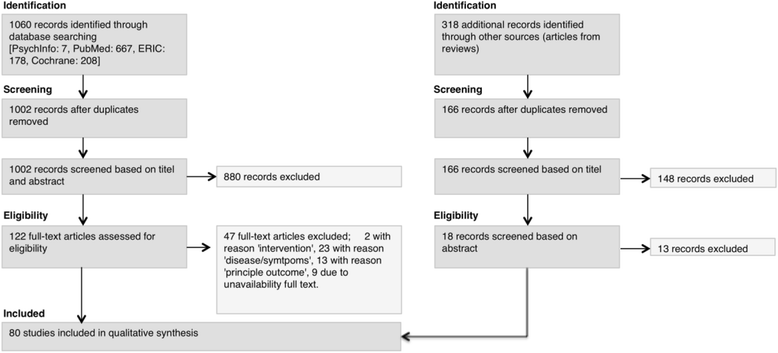The search for relevant outcome measures for cost-utility analysis of systemic family interventions in adolescents with substance use disorder and delinquent behavior: a systematic literature review
- PMID: 28927410
- PMCID: PMC5606120
- DOI: 10.1186/s12955-017-0722-9
The search for relevant outcome measures for cost-utility analysis of systemic family interventions in adolescents with substance use disorder and delinquent behavior: a systematic literature review
Abstract
Purpose: Systemic family interventions have shown to be effective in adolescents with substance use disorder and delinquent behavior. The interventions target interactions between the adolescent and involved systems (i.e. youth, family, peers, neighbors, school, work, and society). Next to effectiveness considerations, economic aspects have gained attention. However, conventional generic quality of life measures used in health economic evaluations may not be able to capture the broad effects of systemic interventions. This study aims to identify existing outcome measures, which capture the broad effects of systemic family interventions, and allow use in a health economic framework.
Methods: We based our systematic review on clinical studies in the field. Our goal was to identify effectiveness studies of psychosocial interventions for adolescents with substance use disorder and delinquent behavior and to distill the instruments used in these studies to measure effects. Searched databases were PubMed, Education Resource Information Center (ERIC), Cochrane and Psychnet (PsycBOOKSc, PsycCRITIQUES, print). Identified instruments were ranked according to the number of systems covered (comprehensiveness). In addition, their use for health economic analyses was evaluated according to suitability characteristics such as brevity, accessibility, psychometric properties, etc.
Results: One thousand three hundred seventy-eight articles were found and screened for eligibility. Eighty articles were selected, 8 instruments were identified covering 5 or more systems.
Conclusions: The systematic review identified instruments from the clinical field suitable to evaluate systemic family interventions in a health economic framework. None of them had preference-weights available. Hence, a next step could be to attach preference-weights to one of the identified instruments to allow health economic evaluations of systemic family interventions.
Keywords: Economic evaluation; Externalizing; Instrument; Mental health; Youth.
Conflict of interest statement
Ethics approval and consent to participate
Not applicable.
Consent for publication
Not applicable.
Competing interests
Clazien Bouwmans (CB), Werner Brouwer (WB) and Leona Hakkaart (LH) declare to have no competing interests. Saskia Schawo (SS), Evelien van der Schee (ES) and Vincent Hendriks (VH) are employees of Parnassia Groep, a Dutch mental health institution, which among others offers systemic interventions to its clients.
Publisher’s Note
Springer Nature remains neutral with regard to jurisdictional claims in published maps and institutional affiliations.
Figures
Similar articles
-
Family and parenting interventions in children and adolescents with conduct disorder and delinquency aged 10-17.Cochrane Database Syst Rev. 2001;2001(2):CD003015. doi: 10.1002/14651858.CD003015. Cochrane Database Syst Rev. 2001. PMID: 11406062 Free PMC article.
-
Home treatment for mental health problems: a systematic review.Health Technol Assess. 2001;5(15):1-139. doi: 10.3310/hta5150. Health Technol Assess. 2001. PMID: 11532236
-
Systemic pharmacological treatments for chronic plaque psoriasis: a network meta-analysis.Cochrane Database Syst Rev. 2021 Apr 19;4(4):CD011535. doi: 10.1002/14651858.CD011535.pub4. Cochrane Database Syst Rev. 2021. Update in: Cochrane Database Syst Rev. 2022 May 23;5:CD011535. doi: 10.1002/14651858.CD011535.pub5. PMID: 33871055 Free PMC article. Updated.
-
Cost-effectiveness of using prognostic information to select women with breast cancer for adjuvant systemic therapy.Health Technol Assess. 2006 Sep;10(34):iii-iv, ix-xi, 1-204. doi: 10.3310/hta10340. Health Technol Assess. 2006. PMID: 16959170
-
The cost-effectiveness of family/family-based therapy for treatment of externalizing disorders, substance use disorders and delinquency: a systematic review.BMC Psychiatry. 2016 Jul 13;16:237. doi: 10.1186/s12888-016-0949-8. BMC Psychiatry. 2016. PMID: 27412612 Free PMC article.
Cited by
-
Assessing the relation of chemical and non-chemical stressors with risk-taking related behavior and adaptive individual attributes among adolescents living near the New Bedford Harbor Superfund site.Environ Int. 2021 Jan;146:106199. doi: 10.1016/j.envint.2020.106199. Epub 2020 Oct 27. Environ Int. 2021. PMID: 33126063 Free PMC article.
-
Broadening the application of health technology assessment in the Netherlands: a worthwhile destination but not an easy ride?Health Econ Policy Law. 2021 Oct;16(4):440-456. doi: 10.1017/S1744133120000237. Epub 2020 Aug 6. Health Econ Policy Law. 2021. PMID: 32758331 Free PMC article.
-
Presentation and validation of the Abbreviated Self Completion Teen-Addiction Severity Index (ASC T-ASI): A preference-based measure for use in health-economic evaluations.PLoS One. 2020 Sep 11;15(9):e0238858. doi: 10.1371/journal.pone.0238858. eCollection 2020. PLoS One. 2020. PMID: 32915870 Free PMC article.
-
Obtaining preference scores for an abbreviated self-completion version of the Teen-Addiction Severity Index (ASC T-ASI) to value therapy outcomes of systemic family interventions: a discrete choice experiment.Eur J Health Econ. 2024 Jul;25(5):903-913. doi: 10.1007/s10198-023-01633-3. Epub 2023 Sep 27. Eur J Health Econ. 2024. PMID: 37755542 Free PMC article.
References
-
- Brysbaert M. Psychologie. Gent: Academia Press; 2009.
-
- Hendriks V, van der Schee E, Blanken P. Treatment of adolescents with a cannabis use disorder: main findings of a randomized controlled trial comparing multidimensional family therapy and cognitive behavioral therapy in The Netherlands. Drug Alcohol Depend. 2011;119:64–71. - PubMed
References (systematic review results; see Table 2 & Table 3)
Publication types
MeSH terms
LinkOut - more resources
Full Text Sources
Other Literature Sources
Medical



